How to Change a Tyre in 9 Simple Steps

The wild and vast nature of Australia's landscape means that any time you could be hundreds of kilometres away from the nearest mechanic, without phone or internet service, and hours away from roadside assist. For the times that you find yourself stranded with a flat, knowing how to change a tyre is an essential skill.
While changing a tyre roadside is the ultimate inconvenience, it's really not too hard to do. If you're prepared with a few basic tools, you can be safely back on the road in no time at all. To help you through the process, we've put together some easy to follow step-by-step instructions on how to change a tyre.
What tools do you need to change a tyre?
Thankfully you can change a tyre without any extravagant equipment. All you need is a few simple and easy-to-use tools.
Essential tools (keep these in your car at all times)
- Spare Tyre
- Jack
- Wrench
- Car Manual
Useful items
You can quite easily change a tyre with just the essential items mentioned above, but the truth is that you never know the conditions you'll find yourself in when you need to roll up your sleeves. Rain, snow, little or no light and uneven terrain can all make the experience less than favorable. So here are some extra items you may like to keep in your car in case you ever need them.
- A large torch or flashlight
- Spare batteries (nothing is more frustrating than when your torch goes flat in the dark)
- Wheel wedges
- Gloves
- A raincoat or poncho
How to change a car tyre

1. Find somewhere safe and flat
As soon as you notice that you have a flat, it's important to seek a safe place to stop. Look for a long, flat stretch of road that is well out of the way of passing traffic. Driving on a flat tyre can damage your rim, but stopping in an unsafe location puts yourself and others at risk of a serious accident. If you have to drive a few hundred meters more in order to find a safe place to stop, then continue to drive slowly and safely until you do.
Changing a tyre roadside is the ultimate inconvenience, but it's really not too hard to do. If you're prepared with a few basic tools, you can be safely back on the road in no time at all.
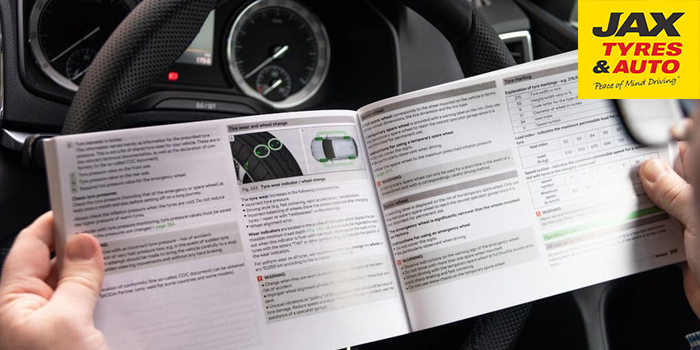
2. Review your car manual
Once you have safely pulled over, pull up your hand brake, switch on your hazard lights and have a look through your car manual for any vehicle-specific instructions on changing your tyre.
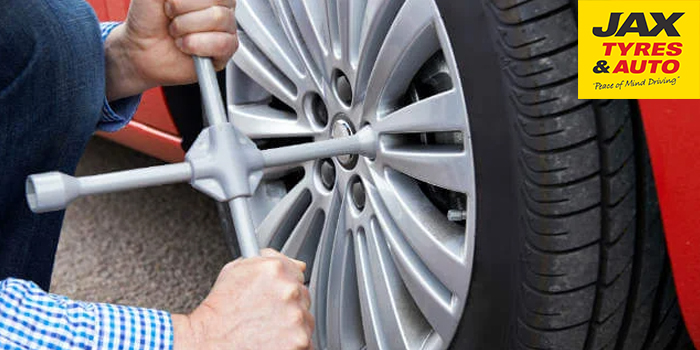
3. Loosen the bolts
Start by removing hubcaps (if your car has them) from the flat tyre(s). Use your wrench to loosen the bolts by turning each of them once counter-clockwise. They may be a little stiff, so don't be afraid to use your body weight or foot to get them started.
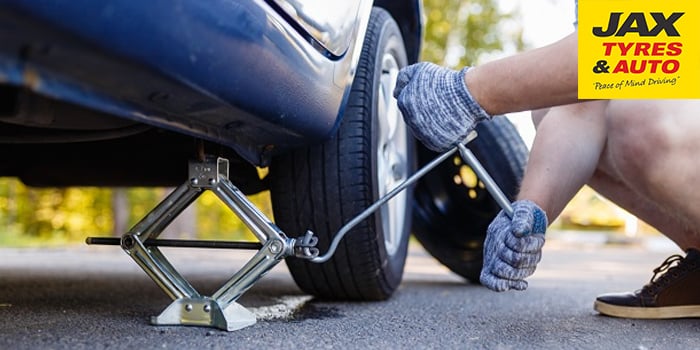
4. Jack up the car
Refer to your car manual to locate the correct place to jack up your car, as this can vary between vehicles. Once you have placed the jack in the correct position, you can use the jack to lift your car to roughly six inches off the ground.
NOTE: Never put your body underneath your car during or after raising.
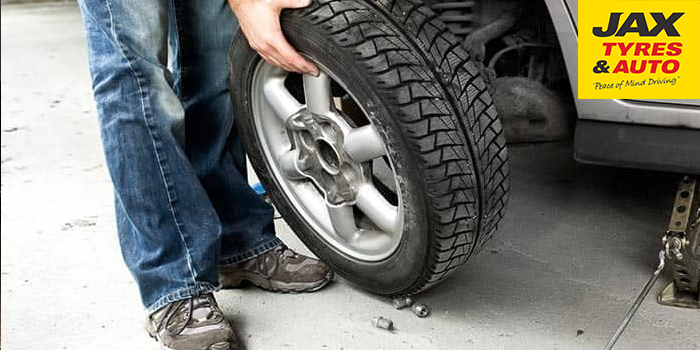
5. Take off the bolts and remove the tyre
With the bolts already loosened, you should now be able to fully remove them by hand. Once the bolts are off, you can carefully remove the tyre - but be careful, they are heavier than they look.
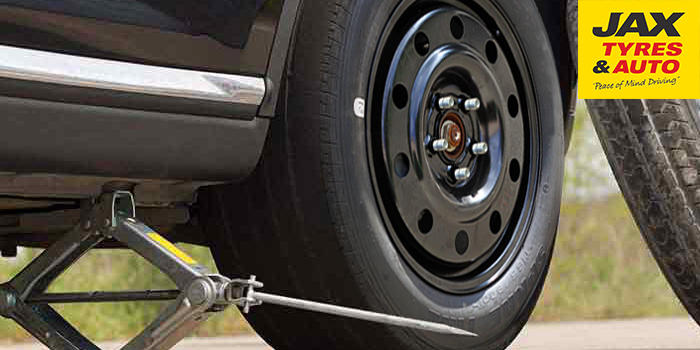
6. Place the spare tyre into position
Check that your spare tyre is adequately inflated and then carefully lift it into position.
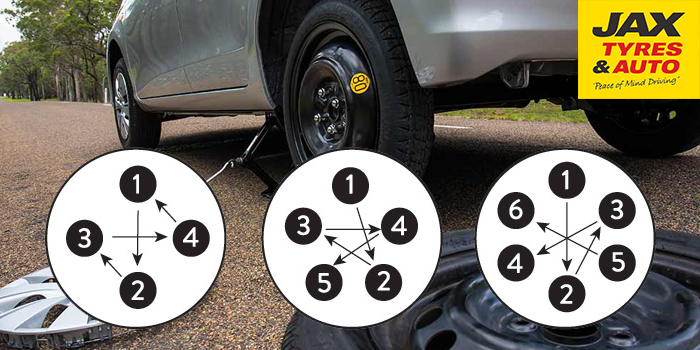
7. Hand-tighten the bolts in a star pattern
With the car still jacked, hand-tighten the bolts onto the spare tyre. Tighten them as much as possible by hand, and you'll finish tightening them with the wrench once the car is lowered off the jack.
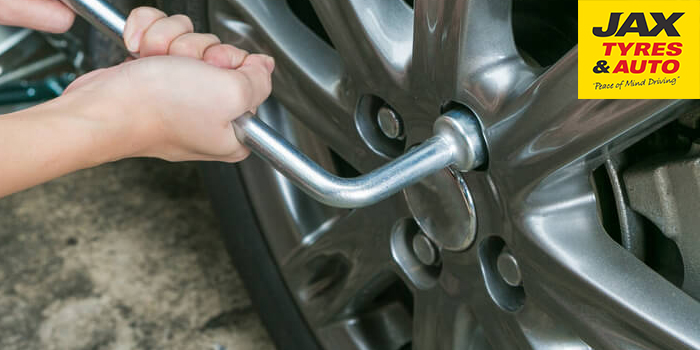
8. Lower the car off the jack and tighten the bolts
Carefully lower the car off the jack and use your wrench to finish tightening the wheel bolts to the recommended force.

9. Head to a tyre professional
A tyre professional will be able to check and replace your tyres as required. While you're there, it's a great idea to pick up a replacement spare so that you're always prepared in the event of another puncture or flat.
How long does it take to change a tyre?
Changing a tyre should take you anywhere between 10 minutes and half an hour to do properly. But, if it takes a little longer, that's ok. The main thing is to ensure that you follow all of the steps and have a safely fitted tyre once you're done.
If you've recently had a flat tyre, speak to the team at Jax. Whether you need a tyre repair, replacement, or simply want the peace of mind that comes with seeing a professional, you'll find an affordable option to suit your budget and keep you safe on the road.
Book your car in for a 5-star Vehicle Service at JAX Tyres & Auto Today!
Usually with the right tools, you can change your tyres by yourself safely and without any problems, but it does involve getting your car up in the air. However, there are instances where you should seek help. Suppose your vehicle has a direct Tyre Pressure Monitoring System (TPMS). In that case, it is advisable to have the tyre swap done professionally in a garage.
To replace a tyre by yourself, you will need:
- A car jack. This allows you to lift the car off the ground to change the tyre. They come in various sizes, with different loading capacities and different features. A car jack with a load capacity of at least two tonnes is usually sufficient.
- A cross wrench. Also known as a 4-way wheel brace. Use this to loosen the wheel nuts and tighten them up again. You should always check that the cross wrench fits your specific tyre size.
- Torque wrench. With a torque wrench, you can ensure that you tighten the wheel nuts correctly. This is extremely important for the seating and the wheel grip.
- Wire brush. To remove loose rust and dirt for the wheel hub.
Grease pencil. Use this to mark the original positions of your tyres.
Suppose the vehicle you’re changing a tyre on has a manual gearbox. You don’t want your car to be in neutral as this causes the connection from your engine to your wheels to disconnect. In that case, it’s essential that you put your vehicle into the correct gear.
You want to leave the engine off before you start the tyre change, but you should leave the gearstick in either first or reverse gear.
The reason for this is that the handbrake only operates on two wheels - usually the rear wheels. If you put the car in first or reverse gear with the engine off, this creates the effect of locking the front wheels, which are the driven wheels for most cars.
It would be best if you didn’t change a tyre with somebody in the car. Having someone moving in the car while you change the tyre can add unnecessary and unbalanced weight making the job more challenging and risking your passenger’s safety. Make sure any passengers with you (humans and pets) get out of the vehicle before you begin changing the tyre.
The reason is that while car jacks can temporarily lift the car, having the vehicle on three wheels leaves it in a precarious position. Even a slight shift in the passengers’ weight can send the car toppling, which could damage the wheel hub, chassis and even worse, your passenger.
When changing a tyre, you should always set the emergency brake and if your car is an automatic, put the lever in “park”. This vital safety precaution will ensure the rear wheels don’t spin during the tyre swap. It would help if you also took preventative measures like blocking the tyres and changing the tyre on flat ground to keep the vehicle from rolling.
- Never change the tyre on the side of the road unless absolutely necessary.
The best thing to do in the event of a flat on the highway is to get off at the next edit or stay buckled in your car until help arrives if your vehicle is too disabled to move. - Never leave lug nuts too loose.
You should follow the directions in your owner’s manual for how loose the lug nuts are. If you don’t tighten each bolt properly, you risk damaging the heel or the lug nuts themselves. You’ll most likely hear a strange road nose or experience “wobbling” in the event of loose lug nuts. - Never change a tyre on unstable ground.
The reason is that while car jacks can temporarily lift the car, having the vehicle on three wheels leaves it in a precarious position. The jack could also slip from under the vehicle and injure you. - Use incorrect jacking points.
Placing the jack in the incorrect position under your car and jacking it up can cause damage to your vehicle. If you use a jack on unstable ground and it gives way, you could cause damage to yourself and your passengers. - If you’re unsure where the jacking points are, check your owner’s manual. It will vary with the vehicle’s make and model, but generally, they’re just behind the front wheels and just in front of the rear wheels. These points are reinforced and made to hold the car’s weight on the jack.
- Never crawl under the car while it’s on a jack.
Under no circumstance is it a good idea to check out your vehicle’s undercarriage at this time. The car can, and often does, fall off the jack if it wasn’t placed perfectly. Crawling under the car can cause serious injury to yourself if the car topples.
If the lug nuts have been over-overtightened previously, they can be almost impossible to loosen manually. This can not only be an issue for those with well-developed biceps, but overtightening can also cause irreversible damage to the threads.
For steel wheel nuts is usually around 80ft/lb, and for aluminium wheels, it’s 100ft/lb. When doing it by hand, the general rule is to tighten the wheel nuts just enough to hold the wheel snugly.

